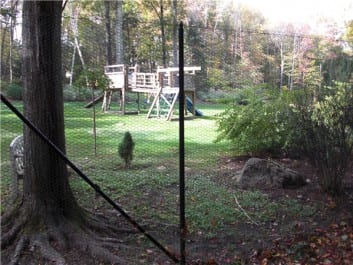 A common goal for inserting a fence is controlling animals. Whether you want to keep them in an area or restrict their access to the enclosed area, each situation requires a different type of fence.
A common goal for inserting a fence is controlling animals. Whether you want to keep them in an area or restrict their access to the enclosed area, each situation requires a different type of fence.
The following are fence recommendations for animals you need to keep in and out.
Pets
Fences are commonly installed to keep pets from escaping a property. Dogs are typically the most commonly fenced-in pet. The type of dog you have can help you determine the style of fence you need. Smaller dogs require fences that are set on the ground and have narrow picket spacing. Large breed dogs may be able to dig under or jump above a fence, so it is important to plan accordingly. Medium breed dogs may be the easiest to fence in.
Livestock Control
Cattle. For cattle, a barb wire fence or high tensile wire fence is usually sufficient.
Chickens. For chickens, a four foot tall fence with no larger than a 1 inch wire mesh will contain chickens effectively.
Horses. Horses are capable of jumping a four foot tall fence, but are typically unwilling to jump a five foot fence. More powerful horses, such as stallions, will jump over a five foot fence and require at least a six foot tall fence. The most common fencing solution for horses is a post and rail fence.
Wildlife Control
Deer. Deer are amazing jumpers. You will need at least a six foot tall fence, and the top of the fence should be smooth to prevent the deer from getting caught in the top of the fence. Some recommend that the fence be built at a 45-degree angle, with the high side of the fence facing the deer.
Rabbits. Chicken wire is sufficient to prevent rabbits from getting into your property or garden. If you already have a fence, chicken wire can be attached to the bottom of the fence to provide a rabbit barrier. Be sure to place your rabbit fence in the ground to prevent the rabbits from digging under the fence.
Raccoons/Possums. Raccoons and possums are climbers, and have little problem getting over or through most fences. Unfortunately, they are also diggers, and have no trouble digging under a fence. If you have a severe problem with raccoons or possums, you can put plastic mesh at the top of your fence that comes loose when the animal climbs. You can include a hot wire on the top of your fence that shocks the animal as it tries to climb over (not recommended for residential areas). To prevent the animals from digging, you can bury a mesh style fence six to twelve inches underground.
If you have questions or need assistance with installing a fence, give us a call at Riverside Fence!

